|
一般在写方法的时候,第一步就是进行参数验证,这也体现了编码者的细心和缜密,但是在很多时候这个过程很枯燥和乏味,比如在拿到一个API设计文档的时候,通常会规定类型参数是否允许为空,如果是字符可能有长度限制,如果是整数可能需要判断范围,如果是一些特殊的类型比如电话号码,邮件地址等,可能需要使用正则表达式进行判断。
通常,我们一般都是在方法开始的地方进行条件判断,然后抛出合适的异常,这是最普通和通用的做法,但是在.NET中,利用一些语言特性和类库,可以使用一些其他的方式将我们从复杂繁琐的工作中解放出来。本文逐一介绍能够用来进行参数验证的方式,他们包括直接判断语句,帮助类,扩展方法,Customer
Attribute,Enterprise Liberary,Debug.Assert,Code Contract等。可以看到在.NET中随着版本的演化,逐步添加了很多声明式编程(Declarative
programming)的风格,这样的代码会直接表明what而不是how,从而使得代码更加清晰和易维护。
现在来看下这些参数验证的方法。
一 一般的方法
假设我们有一个方法如下,用来进行登记注册,需要传入姓名和年龄。
public bool Register(string name, int age)
{
//insert into db
} |
当然,不是传进什么东西都能调用我们的方法。一般地,我们首先要做的是,对参数进行合法性验证,比如如果要参加上海国际马拉松比赛,需要年龄大于10岁小于70岁。一般的验证方法如下:
public bool Register(string name, int age)
{
if (string.IsNullOrEmpty(name))
{
throw new ArgumentException("name should not be empty", "name");
}
if (age < 10 || age > 70)
{
throw new ArgumentException("the age must between 10 and 70","age");
}
//insert into db
} |
我们会发现,如果每一个方法都这样判断的话,非常麻烦和繁琐。于是就想到把他提取到一个帮助方法中。
public static class ArgumentHelper
{
public static void RequireRange(int value, int minValue, int maxValue, string argumentName)
{
if (value > maxValue || value < minValue)
{
throw new ArgumentException(string.Format("The value must be between {0} and {1}", minValue, maxValue),
argumentName);
}
}
public static void RequireNotNullOrEmpty(string
value, string argumentName)
{
if (string.IsNullOrEmpty(value))
{
throw new ArgumentException("The value can't
be null or empty", argumentName);
}
}
} |
这样,在所有需要进行区间验证和非空验证的地方,调用这个帮助类中的方法即可。
public bool Register(string name, int age)
{
ArgumentHelper.RequireNotNullOrEmpty(name,"name");
ArgumentHelper.RequireRange(age,10,70,"age");
//insert into db
} |
在C#3.0 中,引入了扩展方法,因此可以以一种更优雅的方式来进行参数验证,我们将前面的帮助方法改写如下:
public static class ArgumentHelper
{
public static void RequireRange(this int value, int minValue, int maxValue, string argumentName)
{
if (value > maxValue || value < minValue)
{
throw new ArgumentException(string.Format("The value must be between {0} and {1}", minValue, maxValue),
argumentName);
}
}
public static void RequireNotNullOrEmpty(this
string value, string argumentName)
{
if (string.IsNullOrEmpty(value))
{
throw new ArgumentException("The value can't
be null or empty", argumentName);
}
}
} |
这样,我们的验证变成了如下:
public bool Register(string name, int age)
{
name.RequireNotNullOrEmpty("name");
age.RequireRange(10,70,"age");
//insert into db
} |
有了扩展方法,就可以写出很多类似LINQ的比较流畅的验证语句来。一些类似的验证类库也提供了类似功能。如FluentValidation,CuttingEdge.Conditions等。比如这里取自CuttingEdge.Condition
里面的例子。
public ICollection GetData(Nullable<int> id, string xml, IEnumerable<int> col)
{
// Check all preconditions:
Condition.Requires(id, "id")
.IsNotNull() // throws ArgumentNullException on failure
.IsInRange(1, 999) // ArgumentOutOfRangeException on failure
.IsNotEqualTo(128); // throws ArgumentException on failure
Condition.Requires(xml, "xml")
.StartsWith("<data>") // throws
ArgumentException on failure
.EndsWith("</data>") // throws
ArgumentException on failure
.Evaluate(xml.Contains("abc") || xml.Contains("cba"));
// arg ex
Condition.Requires(col, "col")
.IsNotNull() // throws ArgumentNullException on
failure
.IsEmpty() // throws ArgumentException on failure
.Evaluate(c => c.Contains(id.Value) || c.Contains(0));
// arg ex
// Do some work
// Example: Call a method that should not return
null
object result = BuildResults(xml, col);
// Check all postconditions:
Condition.Ensures(result, "result")
.IsOfType(typeof(ICollection)); // throws PostconditionException
on failure
return (ICollection)result;
} |
利用扩展方法也可以写出如下图中这种比较搞笑的语句。
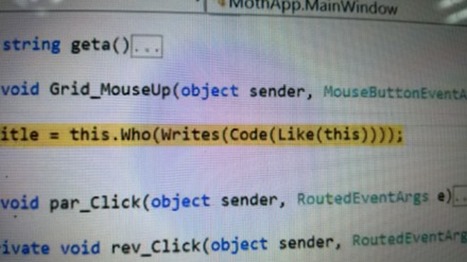
二 使用类库或者框架
除了自己写方法之外,一些类库和框架也提供了参数验证的模块。
微软企业库(Enterprise Liberary)中提供了一个名为Validation Application
Block的组件,专门用来验证。安装之后,运行EntLibConfig.exe 就可以使用界面的方式来添加验证
还是以前面的代码为例子。我们将name和age封装为一个名为Person的类的字段,然后使用企业库来进行验证。允许EntLibConfig.exe,加载我们编译好的dll或者exe,然后选择需要验证的字段或者方法,然后添加合适的验证规则,如下图:
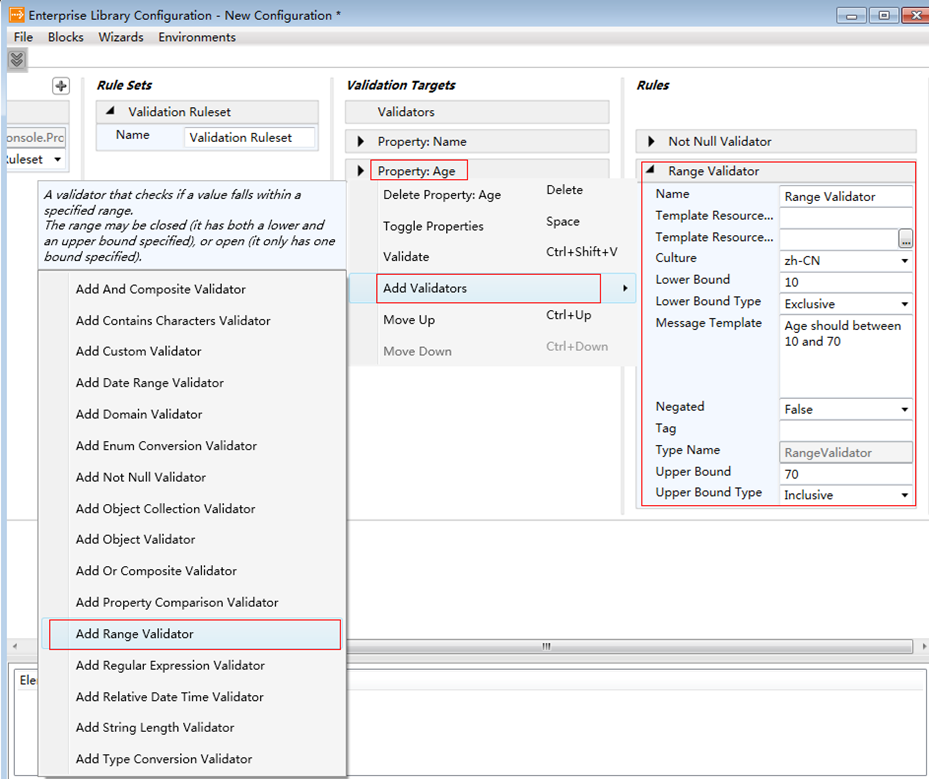
完成之后,保存为app.config文件,该文件内容如下:
<configuration>
<configSections>
<section name="validation" type="Microsoft.Practices.EnterpriseLibrary.Validation.Configuration.ValidationSettings,
Microsoft.Practices.EnterpriseLibrary.Validation, Version=5.0.414.0, Culture=neutral,
PublicKeyToken=31bf3856ad364e35" requirePermission="true" />
</configSections>
<validation>
<type name="ValidationConsole.Program+Person" defaultRuleset="Validation Ruleset"
assemblyName="ValidationConsole, Version=1.0.0.0, Culture=neutral, PublicKeyToken=null">
<ruleset name="Validation Ruleset">
<properties>
<property name="Name">
<validator type="Microsoft.Practices.EnterpriseLibrary.Validation.Validators.NotNullValidator,
Microsoft.Practices.EnterpriseLibrary.Validation, Version=5.0.414.0, Culture=neutral, PublicKeyToken=31bf3856ad364e35"
messageTemplate="姓名不能为空" name="Not Null Validator" />
</property>
<property name="Age">
<validator type="Microsoft.Practices.EnterpriseLibrary.Validation.Validators.RangeValidator,
Microsoft.Practices.EnterpriseLibrary.Validation, Version=5.0.414.0, Culture=neutral, PublicKeyToken=31bf3856ad364e35"
culture="zh-CN" lowerBound="10" lowerBoundType="Exclusive"
upperBound="70" messageTemplate="Age should between
10 and 70
"
name="Range Validator" />
</property>
</properties>
</ruleset>
</type>
</validation>
</configuration>
|
可以看到企业库实际上是生成一个app.config文件,然后在文件中写入了参数的验证条件,然后在运行的时候引用企业库的相关dll进行验证。参数验证是可以配置的,具体的使用方法如下:
public class Person
{
public string Name { get; set; }
public int Age { get; set; }
public Person(string name, int age)
{
this.Name = name;
this.Age = age;
}
}
static void Main(string[] args)
{
Validator<Person> customerValidator = ValidationFactory.CreateValidator<Person>("Validation
Ruleset");
Person myCustomer = new Person("admin",9);
ValidationResults validateResult = customerValidator.Validate(myCustomer);
if (!validateResult.IsValid)
{
for (int i = 0; i < validateResult.Count; i++)
{
Console.WriteLine("验证出错 {0}:" + validateResult.ElementAt(i).Message,
i + 1);
}
}
else
{
Console.WriteLine("正确");
}
Console.ReadKey();
} |
运行结果如下:

ASP.NET MVC
还可以利用自定义属性(Customer Attribute)来进行参数验证,ASP.NET MVC 的Model中就是使用数据标记(Data
Annotations)这种属性来进行验证。Data Annotations其实是一系列继承自Attribute的可以用在类或者类的属性上的自定义属性类。
System.ComponentModel.DataAnnotations
程序集中内建有一些诸如 Required, Range, RegularExpression and StringLength的类,
这些自定义属性类都继承自ValidationAttribute抽象类:
public abstract class ValidationAttribute : Attribute
{
public string ErrorMessage { get; set; }
public virtual bool IsValid(object value);
protected virtual ValidationResult IsValid(object
value, ValidationContext
validationContext);
// other members
} |
如果在ASP.NET MVC 中,我们的Person Model就可以写成如下:
public class Person
{
[Required]
public string Name { get; set; }
[Range(10, 70)]
public int Age { get; set; }
} |
很简洁,在编写实体类的时候,就可以顺便把验证规则给定了。这样,我们在实例化Person类,然后调用框架中相应的方法,如果不满足条件,就会抛出相应的异常。
PostSharp
一些商业软件,更是将利用属性进行验证做到了极致,比如PostSharp这款商业软件。下面是该网站的宣传页:
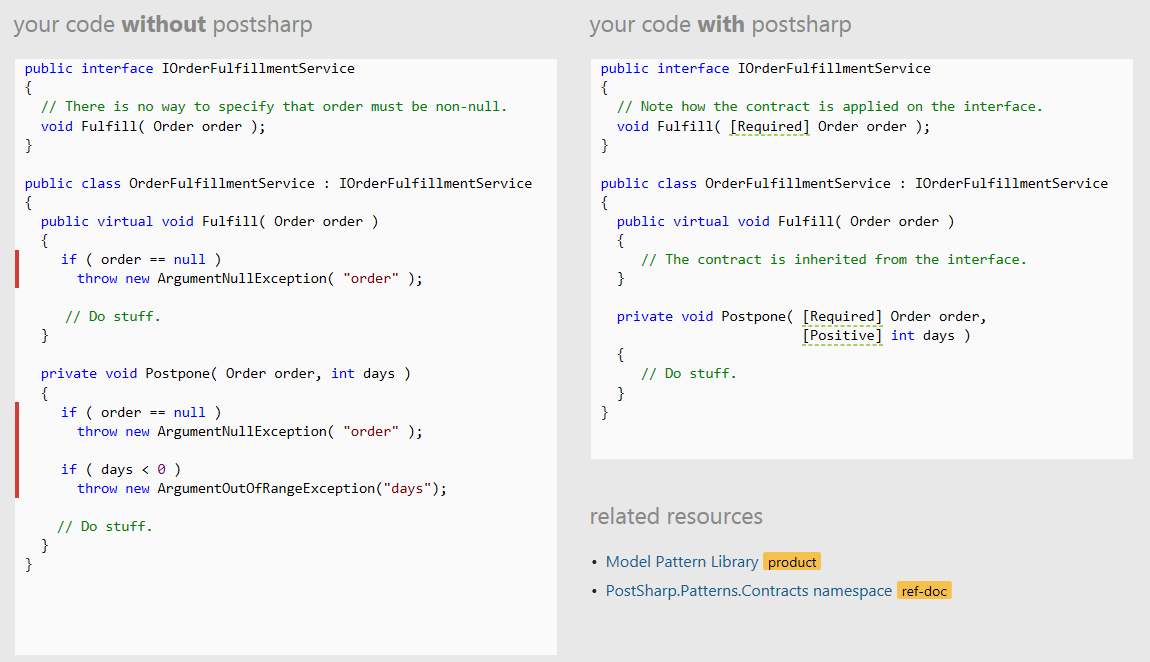
可以看到,在方法的参数中,可以在前面使用自定义属性来标记,然后在系统运行的时候进行动态的验证。
PostSharp使用的是一种所谓静态注入的方式,也就是在编译好的程序集中的类型或者某个方法里注入IL代码,是在代码编译的时候,而不是在运行时注入的。Visual
Studio通过MSBuild来执行生成过程,PostSharp是把自己作为一系列的Build Task来插入到代码生成过程中来的。其原理可以参看
.NET下的AOP: PostSharp 原理分析 这篇文章。这里引用了文中的一幅图,很形象的说明了PostSharp的原理:
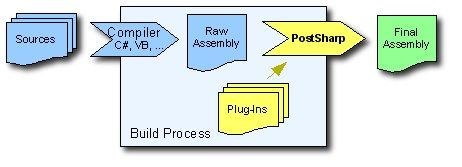
自己动手
其实使用属性来进行验证很简单,我们也可以自己动手来实现类似PostSharp的功能,当然,在使用Customer
Attribute之前,首先您需要了解Attribute这个类, 中文的话,您可以参考CSDN上的Attribute在.net编程中的应用这一些列6篇文章。下面就介绍如何实现PostSharp中的使用自定义属性对参数进行标记验证。其实您看过ASP.NET
MVC 中的System.ComponentModel.DataAnnotations应该就可以知道该怎么实现了。
首先,新建一个ArgumentValidationAttribute抽象类。因为按照约定,所有继承自Attribute的类名称后面必须带有Attribute。这个类中只有一个抽象方法Validate,用来验证。
public abstract class ArgumentValidationAttribute:Attribute
{
public abstract void Validate(object value, string argumentName);
} |
然后,我们定义一个用来验证非空的自定义属性NotNullAttribute,注意到在该类上,我们使用了AttributeUsage属性,在其构造函数参数中,我们传入了
AttributeTargets.Parameter 这个枚举,表明该标记只能用在方法的参数上。
[AttributeUsage(AttributeTargets.Parameter)]
public class NotNullAttribute : ArgumentValidationAttribute
{
public override void Validate(object value, string argumentName)
{
if (value == null)
throw new ArgumentNullException(argumentName);
}
} |
然后定义了一个用来验证范围的InRangeAttribute,这里我们定义了一个构造函数,使得可以传入一个区间范围。
[AttributeUsage(AttributeTargets.Parameter)]
public class InRangeAttribute : ArgumentValidationAttribute
{
private int min;
private int max;
public InRangeAttribute(int min, int max)
{
this.min = min;
this.max = max;
}
public override void Validate(object value,
string argumentName)
{
int intValue = (int)value;
if (intValue < min || intValue > max)
{
throw new ArgumentOutOfRangeException(argumentName,string.Format("min={0},max={1}",min,max));
}
}
} |
有了上面两个类,我们还需要在一个大的框架类验证调用这些验证方法,通常,我们会使用诸如接口注入的方式来实现。这里仅列出关键部分。
public class ValidationInterceptor : IInterceptor
{
public void Intercept(IInvocation invocation)
{
ParameterInfo[] parameters = invocation.Method.GetParameters();
for (int index = 0; index < parameters.Length; index++)
{
var paramInfo = parameters[index];
var attributes = paramInfo.GetCustomAttributes(typeof(ArgumentValidationAttribute), false);
if (attributes.Length == 0)
continue;
foreach (ArgumentValidationAttribute attr in
attributes)
{
attr.Validate(invocation.Arguments[index], paramInfo.Name);
}
}
invocation.Proceed();
}
} |
然后,再回头看我们的代码,我们首先抽象一个IRegister接口:
public interface IRegister
{
void Register([NotNull] string name, [InRange(10, 70)] int age);
} |
可以看到,现在接口中的方法,参数前面已经可以写我们之前定义的用于验证功能的属性了,接口方法中定义了参数的验证规则之后,所有实现该接口的方法中就不需要再次定义了。我们的注册类只需要实现该接口,然后再执行Register之前,统一验证即可。
public class ShMarathon : IRegister
{
public void Register(string name, int age)
{
//doesn't need to validate
//insert into db
}
} |
这种方式其实是AOP(面向方面编程)的一种思想,更多的资料您可以参考AOP in .NET: Practical
Aspect-Oriented Programming和Dependency Injection in
.NET
三 Code Contract
Code Contracts 是微软研究院开发的一个编程类库,我最早看到是在C#
In Depth 的第二版中,当时.NET 4.0还没有出来,当时是作为一个第三方类库存在的,到了.NET
4.0之后,已经加入到了.NET BCL中,该类存在于System.Diagnostics.Contracts
这个命名空间中。
namespace System.Diagnostics.Contracts
{
// Summary:
// Contains static methods for representing program contracts such as preconditions,
// postconditions, and object invariants.
public static class Contract
{
public static event EventHandler<ContractFailedEventArgs> ContractFailed;
public static void Assert(bool condition);
public static void Assert(bool condition, string userMessage);
public static void Assume(bool condition);
public static void Assume(bool condition, string userMessage);
public static void EndContractBlock();
public static void Ensures(bool condition);
public static void Ensures(bool condition, string userMessage);
public static void EnsuresOnThrow<TException>(bool condition) where TException : Exception;
public static void EnsuresOnThrow<TException>(bool condition, string userMessage) where TException : Exception;
public static bool Exists<T>(IEnumerable<T> collection, Predicate<T> predicate);
public static bool Exists(int fromInclusive, int toExclusive, Predicate<int> predicate);
public static bool ForAll<T>(IEnumerable<T> collection, Predicate<T> predicate);
public static bool ForAll(int fromInclusive, int toExclusive, Predicate<int> predicate);
public static void Invariant(bool condition);
public static void Invariant(bool condition, string userMessage);
public static T OldValue<T>(T value);
public static void Requires<TException>(bool condition) where TException : Exception;
public static void Requires(bool condition);
public static void Requires(bool condition, string userMessage);
public static void Requires<TException>(bool condition, string userMessage) where TException : Exception;
public static T Result<T>();
public static T ValueAtReturn<T>(out T value);
}
} |
Code Contract 使得.NET 中契约式设计和编程变得更加容易,Contract中的这些静态方法方法包括
1.Requires:函数入口处必须满足的条件
2.Ensures:函数出口处必须满足的条件
3.Invariants:所有成员函数出口处都必须满足的条件
4.Assertions:在某一点必须满足的条件
5.Assumptions:在某一点必然满足的条件,用来减少不必要的警告信息
Code Contract 的使用文档您可以从官网下载到。为了方便使用Visual Studio开发。我们可以安装一个Code
Contracts Editor Extensions插件。安装完了之后,点击Visual Studio中的项目属性,可以看到如下丰富的选择项:
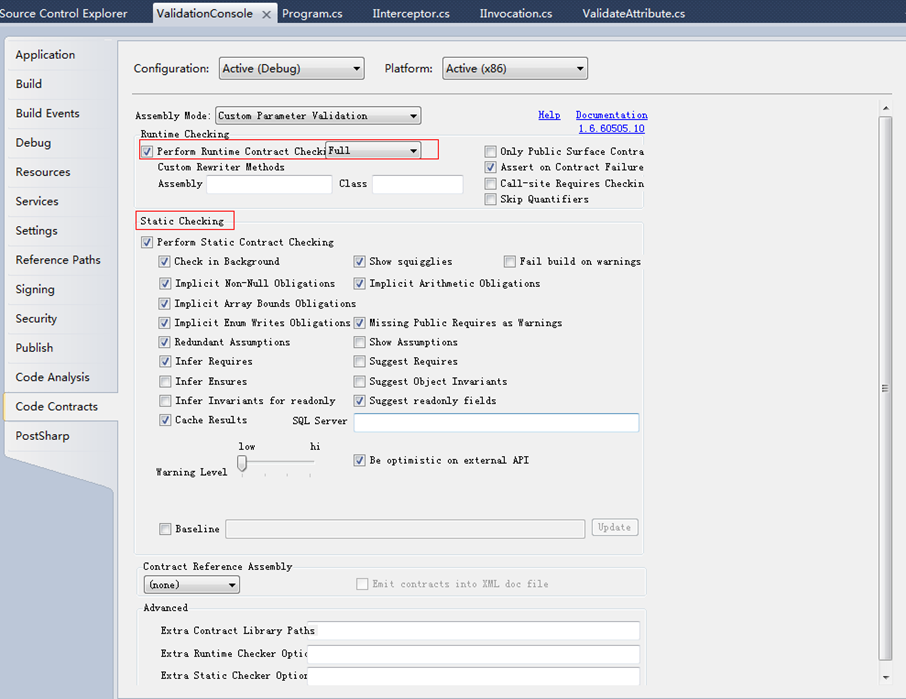
现在,在我们的Register方法中,可以使用Contract来进行判断,使用方式和Debug.Assert类似:
public static bool Register(string name, int age)
{
Contract.Requires(!String.IsNullOrEmpty(name));
Contract.Requires(age > 10 && age < 70);
//insert into db
return false;
} |
当我们传入错误的age值的时候,就会报错:
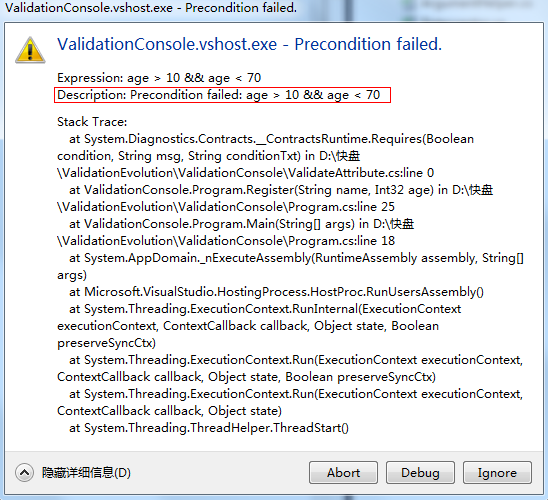
Contract和Debug.Assert有些地方相似:
1.都提供了运行时支持:这些Contracts都是可以被运行的,并且一旦条件不被满足,会弹出类似Assert的一样的对话框报错,如下:
2.都可以在随意的在代码中关闭打开。
但是Contract有更多和更强大的功能:
1.Contracts的意图更加清晰,通过不同的Requires/Ensures等等调用,代表不同类型的条件,比单纯的Assert更容易理解和进行自动分析
2.Contracts的位置更加统一,将3种不同条件都放在代码的开始处,而非散见在函数的开头和结尾,便于查找和分析。
3.不同的开发人员、不同的小组、不同的公司、不同的库可能都会有自己的Assert,这就大大增加了自动分析的难度,也不利于开发人员编写代码。而Contracts直接被.NET
4.0支持,是统一的。
4.它提供了静态分析支持,这个我们可以通过配置面板看到,通过静态分析Contracts,静态分析工具可以比较容易掌握函数的各种有关信息,甚至可以作为Intellisense
Contract中包含了三个工具:
ccrewrite, 通过向程序集中些如二进制数据,来支持运行时检测
cccheck, 运行时检测
ccdoc, 将Contract自动生成XML文档
下图是Contract的原理,图片来自 .NET 4.0中的新功能介绍:契约式设计
(Design By Contracts) 这篇文章, 这也是为什么要比Debug.Assert强大的原因,我们只需要将所有的执行前判断和执行后判断的条件,写到一个地方,然后再编译代码的时候,ccrewrite
会帮我们生成相应的代码,保存起始值,并将相应的代码插入到方法的合适位置。使得我们的代码更加整洁和容易维护。
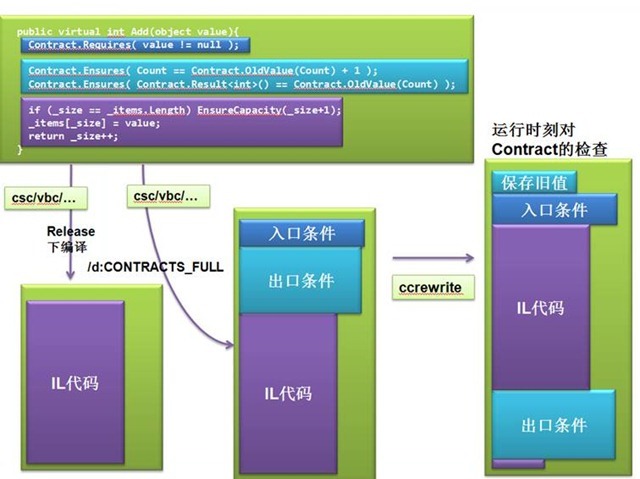
四 总结
本文简单介绍了在.NET 中用来进行方法参数验证的各种方式,包括传统的在方法执行前编写判断语句,提取到公共帮助类中,使用扩展方法,以及一些类库如Enterprise
Liberary,PostSharp,ASP.NET MVC然后实现了一个简单的利用自定义属性来进行方法参数验证的例子,最后介绍了一下.NET
4.0种的Code Contract,在开发中这些验证方式能够统一我们的方法参数验证,在一定的程序上可以减少工作量,希望本文对您有所帮助。
|